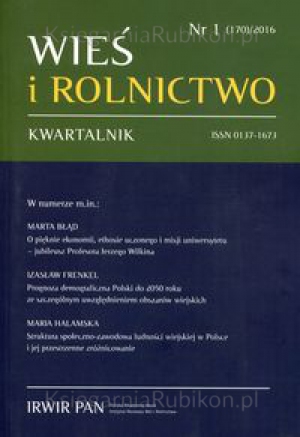Typy obszarów wiejskich w Polsce ze względu na poziom rozwoju społeczno-gospodarczego i dynamikę przedsiębiorstw
Types of rural areas in Poland in terms of level of socio-economic development and dynamics of enterprises
Author(s): Patrycjusz ZarębskiSubject(s): Economy
Published by: Instytut Rozwoju Wsi i Rolnictwa Polskiej Akademii Nauk
Keywords: rolnictwo; modele gospodarstw rolnych; Unia Europejska; agriculture; models of farms; the European Union
Summary/Abstract: The aim of the discussion in this paper was to identify the types of municipalities due to the dynamics of the prevalence of companies with respect to the level of socio-economic development. There were described respectively 4 types of municipalities: sustainable development, unstable growth, slow growth and municipalities closed to development. As a result of statistical analysis it was found that the spatial distribution dynamics of the number of enterprises is not determined by the level of socio-economic development, which was confirmed by low correlation and low coefficient of determination for the linear model.It was noted low growth changes in the number of enterprises in northern Poland, and at the waist border communes in the eastern and north-eastern parts of the country. On the map types (models) of socio-economic development of Polish, it appeared clearly the phenomenon of the polarization and concentration around urban areas. There is a clear division between types of stable development of municipalities, which are located mainly in the western and southern Poland, as well as the municipalities of unstable development of the dominance location in the east of the country.Celem rozważań w niniejszym opracowaniu była identyfikacja typów gmin ze względu na dynamikę występowania przedsiębiorstw w odniesieniu do poziomu rozwoju społeczno-gospodarczego. Opisano odpowiednio cztery typy gmin: stabilnego rozwoju, niestabilnego rozwoju, powolnego rozwoju oraz gmin zamkniętych dla rozwoju. W wyniku przeprowadzonej analizy statystycznej stwierdzono, iż rozkład przestrzenny dynamiki liczby przedsiębiorstw nie jest determinowany poziomem rozwoju społeczno-gospodarczego, co potwierdziła niska korelacja i niska wartość współczynnika determinacji dla modelu liniowego.Zauważono niską dynamikę zmian liczby przedsiębiorstw w Polsce północnej oraz w pasie gmin przygranicznych we wschodniej i północno-wschodniej części kraju. Na mapie typów (modeli) rozwoju społeczno-gospodarczego Polski ujawniło się wyraźnie zjawisko jego polaryzacji i koncentracji wokół aglomeracji miejskich. Wyraźnie widoczny jest podział na typy gmin stabilnego rozwoju, które zlokalizowane są głównie w zachodniej i południowej Polsce, jak również gmin niestabilnego rozwoju z dominacją lokalizacji na wschodzie kraju.
Journal: Wieś i Rolnictwo
- Issue Year: 168/2015
- Issue No: 3
- Page Range: 63-77
- Page Count: 15
- Language: Polish

